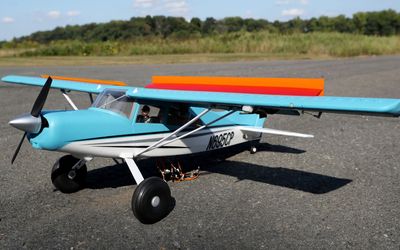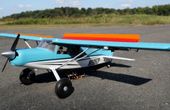Micro Air Vehicle
A micro air vehicles with a single motor and rotor.
Technical Specifications
| Weight of the craft | 358 |
| Weight propellor & motor | 75.8 |
| Diameter bottom rotor | Bottom |
| Top | |
| Drive motor | |
| Propeller rotor disk diameter | 38.6 |
| Thrust | 1 |
| Power | |
| Force/torque sensor | |
| Software |
Overview
This is a concept of a MAV propulsion system capable of using a minimum number of actuators in dual rolls. This simplifies and lowers the cost of MAVs. Removing complex swash plates and reducing the number of actuators reduces the number of parts, thus increases reliability (fewer parts to fail), reduces maintenance costs, reduces vehicle mass, and reduces manufacturing costs.
Design
The drive motor is a Park 400 12-pole, 740 Kv brushless motor suitable for direct drive of large propellers. The three part propeller hub was manufactured on an Object 3D printer from a plastic polymer. The fixed hub interfaces with the motor shaft using a commercial aluminum mandrel, and two custom plastic blade clamps connect to the central hub along steel wire hinges.
The aerodynamic elements are commercial propeller blades from E-flite modified to interface with the custom rotor clamps. The resulting propeller has a rotor disk diameter of 38.6 cm and generates approximately 1 N thrust at 1200 rpm.
The control sensitivity testing indicates that a maximum control moment of 30 N·mm is available from the 38.6 cm rotor. Comparisons can be made to similar platforms. The tiny Syma S107 is a 40 g, 19 cm diameter toy coaxial helicopter whose pitching tail rotor provides approximately 1.7 N·mm of authority to the pilot.
The larger Blade 120SR is a 106 g, 33 cm diameter single propeller helicopter whose cyclic control offers 45 N·mm of moment.1 In contrast, the much larger Ascending Technologies X3D “Hummingbird” quadrotor generates 460 N·mm of rolling moment on its 468 g frame from four 20 cm diameter rotors mounted on 17 cm arms, giving it exceptional maneuverability. The 30 N·mm of control authority allowed by the present prototype should prove sufficient for simple maneuvers in a range of aircraft sizes, but eccentric payload capacity or aggressive maneuvering capabilities may prove limited.
Control Concept
Traditional small scale helicopters and coaxial helicopters already use a single rotor to generate both thrust force and attitude moments. Broadly speaking, thrust comes from the average speed and angle of attack of the propeller blade, and attitude moments are derived from an added cyclic oscillation in the angle of attack through each revolution. This cyclic pitching blade motion is ordinarily proscribed by a swashplate linkage driven by two or three additional servomotors and is sometimes augmented by the dynamics of a stabilizing flybar.
In contrast, we can attain this motion directly from a passive dynamic response of the propeller itself. For such a propeller the mean applied torque sets the rotational speed and thrust, and an applied oscillatory torque induces the desired cyclic oscillation in blade pitch. A simple realization for such an underactuated propeller consists of a rigid hub linked to two semi-rigid airfoil blades, as illustrated in Figs. 1-2.
The vertical motor shaft is fixed to the central hub and transmits torque to the rotor hub. Propeller blades are attached to this hub on either side through simple hinges. The axes of the two hinges lie in the same plane as the vertical propeller axis of rotation, but they are not parallel to the axis of rotation as would be found in typical helicopter rotors. The blade denoted the ‘positive’ blade has the top of its hinge inclined towards the central shaft. Conceptually, this ‘positive’ rotor responds to an impulsive torque on the hub by flexing backwards and exposing increased blade pitch as shown in Fig. 3.
Similarly, a retrograde torque causes the ‘positive’ rotor to flex forwards on its hinge and decrease its pitch. The opposing ’negative’ blade has the top of its hinge axis inclined away from the central shaft, and the complementary geometry creates an opposite response to torques. By superimposing a sinusoidal torque at the rotor frequency on top of the steady torque needed to balance rotor drag, a cyclic oscillation in blade pitch is induced that is phase locked with the rotor position. The motion is functionally similar to that proscribed by a swashplate mechanism, but it is now produced through actuation of only the single main motor.
This motor can now generate attitude moments by, for example, selectively elevating blade pitch in the northern sector and decreasing it in the southern sector through each revolution. By changing the magnitude of the driving sinusoidal modulation the magnitude of the control moment is adjusted, and by changing the phase of the signal relative to the airframe the direction of the control moment in the pitch and roll plane is affected. This linkage can be a simple modification to a propeller blade by manufacturing a flexure joint into an injection molded plastic blade. Forming the blade from a low cost material like polypropylene with good fatigue properties would allow it to withstand many repeated cycles of small angle bending.
A complete vehicle may gain authority over yaw by pairing this novel rotor with a traditional helicopter tail rotor or by adopting a coaxial rotor configuration. In either case, the resulting two actuator system achieves the same degree of control freedom as either a traditional four actuator helicopter or four motor quadrotor. The comparative philosophy of this approach is that the complexity and cost is removed from the physical device and shifted to the control. We can then exploit the advances in computational power, reduced size, power consumption, and cost for these electronic systems.
References
Describes the concept of the MAV propulsion system which is capable of using a minimum number of actuators in dual rolls. Experimental results for the actuator response are presented along with a demonstration of a full flight vehicle using this system for both active stability and maneuvering.










